Report
The internship in International Crop Research institute for the Semi-Arid Tropics (ICRISAT)
Atsushi Yagioka ![]()
Department of Agricultural and Environmental Engineering
United Graduate School of Agricultural Sciences, Tokyo University of Agriculture and Technology
Host Organization: International Crop Research institute for the Semi-Arid Tropics (ICRISAT)
Destination and period: Patancheru, , 2013.11.26 – 2013.12.07
Key words:Sorghum production, Biological Nitrification Inhibition (BNI), nitrate leaching, CGIAR, “Science with a Human Face” mission, leadership
1. The visions and goals of ICRISAT
The International Crop Research Institute for the Semi-Arid Tropics (ICRISAT) is the only one research institute in the world, serving dryland regions. ICRISAT is a member of the CGIAR Consortium, a global agricultural research partnership for a food secure future. The semi-arid tropics cover 55 countries in Asia and sub-Sahara Africa, which has 2 billion people, including 664 million people who are facing low economic condition. Semi-arid tropical regions are mostly vulnerable to climate change with very little rainfall, degraded soils and underprivileged social infrastructure. The vision of ICRISAT is prospering, food-securing and resilient tropical dryland areas by reducing poverty, lack of food, malnutrition and environmental degradation. Due to the visions, ICRISAT conducts research on five highly nutritious and drought tolerant crops, such as chickpea, pigeon pea, pearl millet, sorghum, and groundnut and the management practices.
Headquarters of ICRISAT is located in Patancheru, India, whereas, regional hubs are positioned in Nairobi, Kenya and Bamako, Mali. ICRISAT also has five country offices in sub-Saharan Africa. There are 1,350 ha of total experimental fields in headquarters office. The research division is divided into 1) Resillient
Dryland System, 2) Markets, Institutions, and Policies, 3) Grain Legumes, and 4) Dryland Cereals divisions. Resilient Dryland System Division focuses on reducing vulnerability to drought and climate change by increasing crop diversity and value. Division of Markets, Institutions, and Policies pursues to develop inclusive prosperity of social science approach. The objective of Grain Legumes Division is to raise and secure legumes productivity in term to human health, financial income, and environmental sustainability. In addition, increasing productivity of grain crops is the objective of Dryland Cereals Division to end the universal food problems, lack of food.
The outcomes expected are 1) food sufficiency, 2) intensification, 3) diversification, 4) resilience, 5) health and nutrition, and 6) women empowerment. ICRISAT strongly focuses on its mission that “Science with a Human Face”, inferring that research is not for institution, but it is dedicated to the economically unprivileged societies. The strategy is to apply science and technology for food development and security, poverty reduction, environmental protection, livelihood improvement of small-holder farmers in dryland tropical regions.
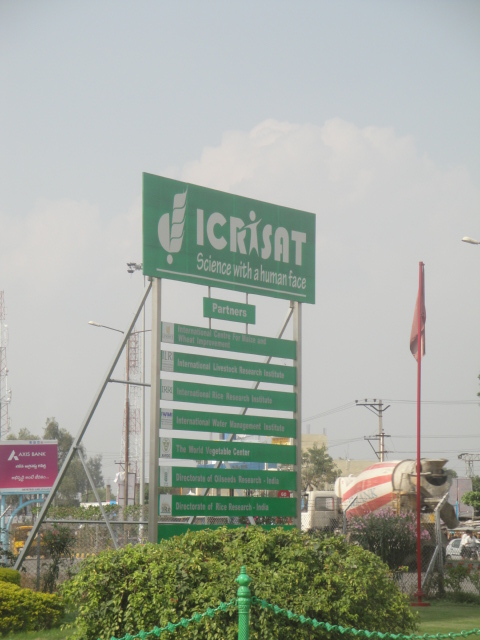 |
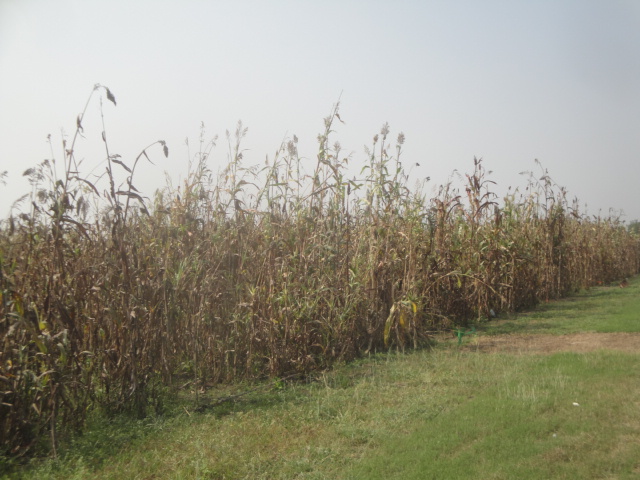 |
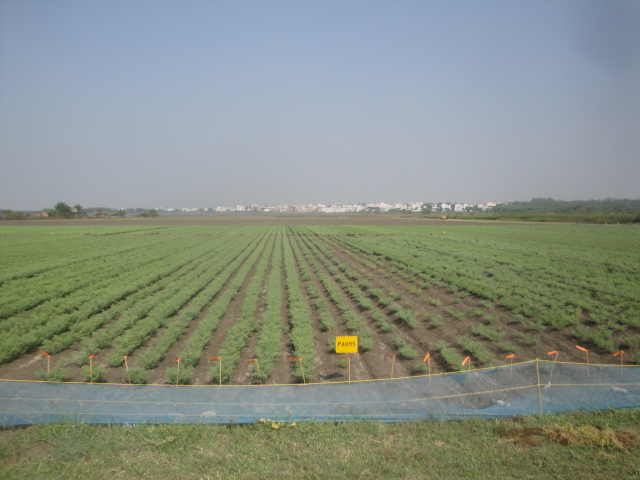 |
| Fig.1. Main gate of ICRISAT | Fig.2. Sorghum field in ICRISAT | Fig.3. Chickpea, one of popular legumes in semi-arid tropics |
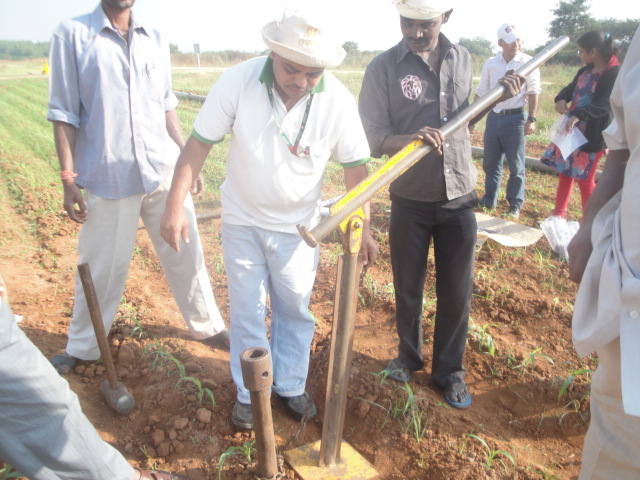 |
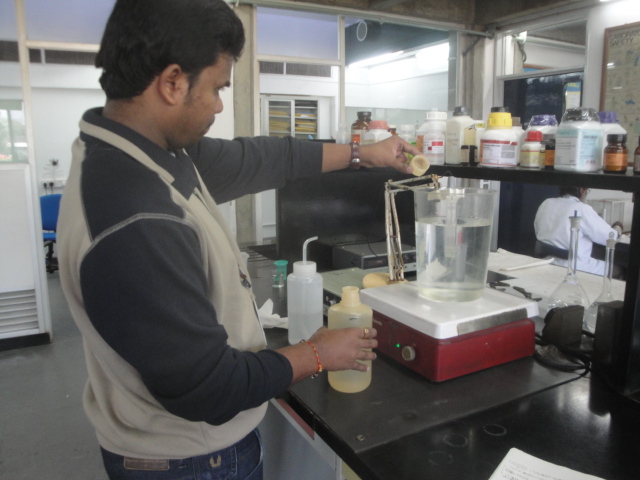 |
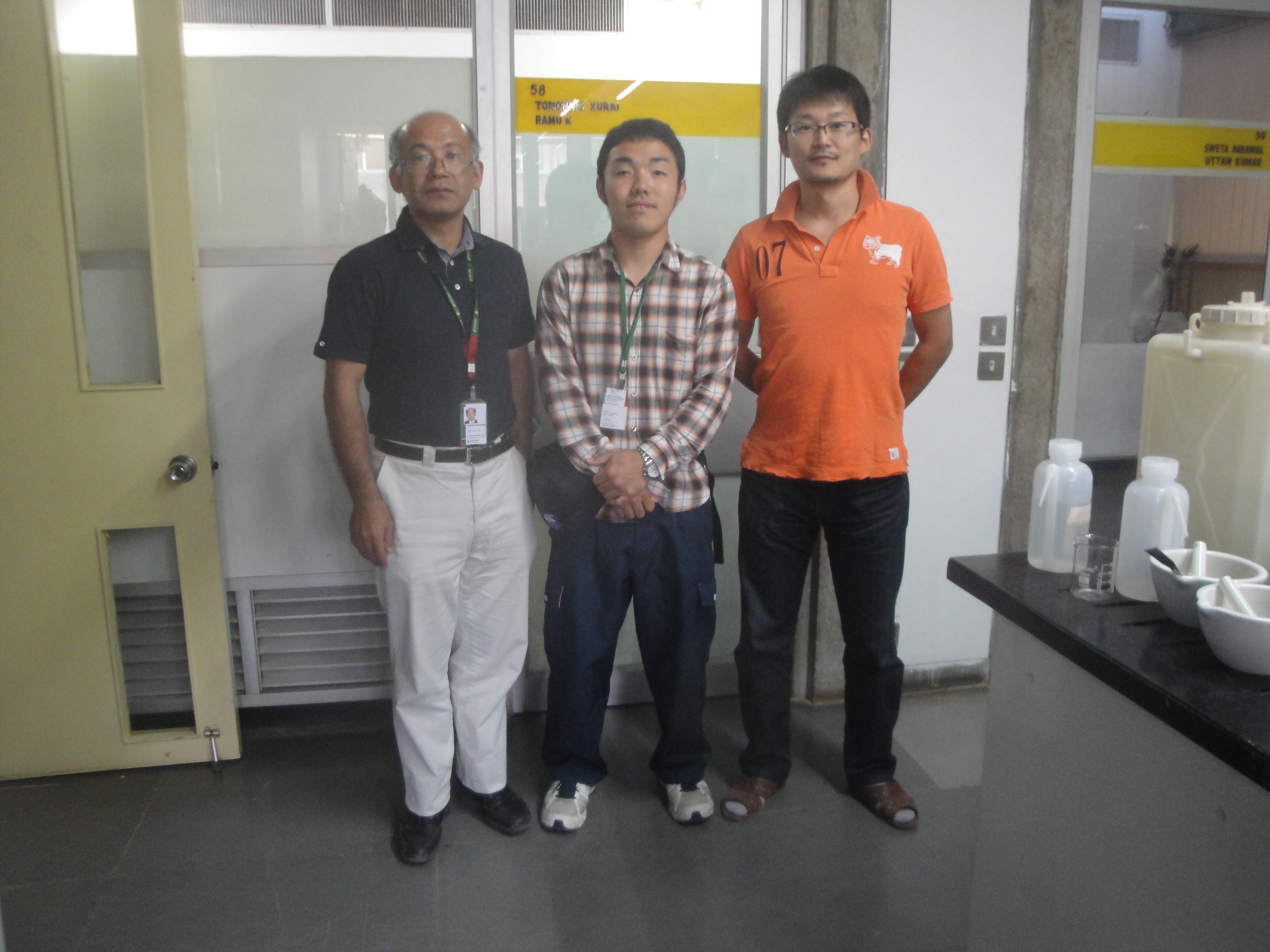 |
| Fig.4. Soil sampling | Fig.5. Preparation of soil analysis | Fig.6. Staff of ICRISAT, Dr. Watanabe (left side) and Dr. Kurai (right side). |
2. The backgrounds of BNI project
The project of Biological Nitrification Inhibition (BNI) is a five-year cooperative research project between Japan International Research Center for Agricultural Sciences (JIRCAS) and ICRISAT. The project was established in October 2009, in which, the term of this internship was in the transition period from the fourth to the fifth year of the project. The aims of BNI project are 1) to clarify the most efficient field conditions for BNI potentials of sorghum, 2) to investigate BNI activities in soil condition, and 3) to apply BNI in the field in order to obtain new fertilization guideline and recommend effective crop rotation system of sorghum.
Sorghum plants, both grain and sweet sorghum, is one of the main grain crops in semi-arid tropical regions. Sorghum has been known as crops which needs abundant amount of nitrogen fertilizer. However, the price of nitrogen fertilizer is rising over recent years, causing another financial problem for farmers. Furthermore, the existence of nitrogen fertilizer in soil possibly causes environmental pollution through nitrate leaching, nitrous oxide emission, and nitrogen volatilization. Cost of nitrogen fertilizer loss from the field without being used by crops is estimated recently with equivalent to approximately 17 billion dollars per year worldwide. Nitrification is one of N-cycle pathways in the soil involving microbiological activity. Principally in nitrification, immobile NH4+ is converted into highly mobile NO3- which is potentially lost via nitrate (NO3) leaching, and gaseous N emissions (N2O, NO and N2) by denitrification. In this case, controlling nitrifier activity to improve nitrogen use efficiency (NUE) of agricultural production systems is important.
Plant roots can release nitrification inhibitors for suppressing soil nitrification. The inhibitors have been termed as biological nitrification inhibition (BNI). ICRISAT has found that sorghum has ability producing BNI. Until today, three kinds of nitrification inhibitors, MHPP (methyl 3-(4-hydroxyphenyl) propionate), sakuranetin (5,4’-dihydroxy-7-methoxyflavanone) and sorgoleone (2-hydroxy-5-methoxy-3-[(8’Z,11’Z)-8’,11’,14’-pentadecatriene]-p-benzoquinone) have been isolated from sorghum roots cultured hydroponically through this experiment. Releasing of nitrification inhibitor by sorghum roots requires presence of NH4+. Additionally, soil pH contributes as limiting factor of BNI (for example, nearly 80% of hydrophilic-BNI released was suppressed at pH ≥7.0).
BNI has succeeded to be applied in hydroponic cultivation system. The results can be useful fundamental knowledge towards utilization research of BNI in sorghum. Application of BNI in field based on soil cultivation with extra complex condition is potentially studied and improved in the future.
3.Experiences in internship
Internship was done in the headquarter office of ICRISAT in Patancheru, India. It was held on weekdays from 8.00 a.m. to 5.30 p.m. for 10 days, from 27 November to 6 December. Internship activity was conducted mainly in Soil Biochemistry Laboratory of Resilient Dryland System Division. The host researcher was Dr. Takeshi Watanabe, a special project scientist expert on soil science. There are three scientific staff in the laboratory, managing and conducting the research. Three field managers who have responsibility in experimental field also work in the same laboratory. More than ten workers are hired to support field management and experimental preparations. In addition, there was a Japanese post-doctoral fellow, Dr. Tomohiro Kurai who is specialized in plant physiology. I followed mainly two tasks during the internship program. The first task was joining the annual meeting of the BNI project and a discussion session between the researchers of JIRCAS and ICRISAT. The second task was supporting parts of the BNI project by taking soil sampling and analyzing nitrate and ammonium content of soil. In addition, I followed the scientific staff to guide and manage field management of sorghum cultivation field.
The annual meeting of the BNI project was held by ICRISAT on November 28 and 29. Twenty researchers attended the meeting, including host researchers, researchers from related projects, Japanese staff of Agriculture Ministry, and researchers of JIRCAS. The BNI project has been conducted for four years since October 2009. This year will be the last year of the project. The present aim of this project is to identify BNI from sorghum plants in field and evaluate its effectiveness of the application in soil cultivation system in field. In order to evaluate the effectiveness, new fertilizer guideline for treated sorghum plants by BNI is conducted. The tasks are divided for each researcher, for instance Dr. T. Watanabe conducts BNI measurement through soil chemical analysis, such as soil nitrate and soil ammonium dynamics. Moreover, Dr. T. Kurai observes soil micro-organisms’ activities which contribute to releasing of nitrification inhibition substances by sorghum roots. This project has succeeded in detecting and evaluating existence of BNI from sorghum roots in controlled environmental cultivation system, such as hydroponics. Nevertheless, the similar procedure in soil cultivation medium has not resulted in great outcomes as expected yet. It is related to soil micro-organisms’ activities which possibly consume BNI, causing losses of BNI in large amount. According to this disadvantage, Dr. Kurai measures population of nitrification inhibitor substances from hydroponics, ammonia-oxydizing archea (AOA) and ammonia-oxydizing bacteria (AOB), using real-time PCR method, however, those substances were not detected in the soil. Further, the experimental soil type is Alfisols, having lower nitrification rate, makes it more difficult to determine whether nitrification inhibition is caused by BNI substance from sorghum root or originated from soil characteristics of Alfisols. These experimental problems of should be solved in the future.
Discussion also focused on the effect of soil pH to nitrification inhibition ratio. In general, BNI activity can be activated under low pH soil. At the same time, nitrification pathway itself is also inhibited in low pH condition. These complicated factors in the soil made it difficult to solely understand the nitrification inhibition of sorghum as the effect of BNI. Based on field experiments, the project team constructed a new fertilizer application guideline for sorghum plants. The new application amount of N fertilizer is 63 kg ha-1, equals to 30% less than the currently recommended amount. As subsequent steps, confirming BNI effect in soil and quantifying nitrate leaching reduction by BNI become matters for discussion. Nitrogen tracer technique can be used as a confirmation method.
For the latter part of my internship activities, we sampled soil from sorghum field on 0-100 cm of depth. Nitrate and ammonium content were measured in laboratory after general preparations. The experiment tasks were divided to workers and scientific staff. Soil sampling in sorghum field was done by workers. Nitrogen analysis in laboratory was conducted by scientific staff. In ICRISAT, each position has each job description which is performed appropriately. A host researcher decides experimental steps based on the meeting and discussion. In the experiment, a field manager has responsibility on supervising workers in field. Workers conduct field managements and preparations, and scientific staff analyze and measure experimental samples in detail in laboratory. I also joined Dr. T. Watanabe in visiting activity to three farmer’s field during the internship. Mainly farmers cultivate sorghum and maize as important grain crops. Additionally, most farmers cultivate legumes such as, chickpeas, pigeon peas and groundnuts. Legumes are major source of protein in India, which is related to the custom of Hindu religion of Hindis (Indian people) who usually do not consume meat. Through the visit, I learned traditional farming systems in India.
These are the mixed cropping system of sorghum and pigeon pea, and the crop rotation system between sorghum and chickpea or sorghum and groundnuts. Both mixed cropping and crop rotation systems show effective impacts on crop production and environmental condition. Nowadays, farmers recognize the effectiveness of traditional cropping systems, therefore it is highly recommended that they would continue such systems.
4. Future prospects and ideas for environmental leaders
First, I realized the importance of application of science in the field levels. The missions of ICRISAT as “Sciences with a human face” involve quite important messages for environmental leaders. Based on this mission, ICRISAT continues scientific research and technological development that are applicable to small-holder farmers’ levels in semi-arid tropics. In this case, BNI projects succeeded in identifying BNI compounds in controlled environment of hydroponics. Based on the result, researchers are working to find ways to apply practical techniques and technology to farmer’s levels. Two of the outcomes so far are constructing new fertilizer guidelines for sorghum production and suggesting new crop rotation systems which are effective for the BNI facilitation. It has been known for centuries that excellent research result can be gained excessively under the controlled environment, such as in a laboratory condition and hydroponics cultivation system. Nevertheless, complex condition in field (soil) makes it difficult to gain expected results. This also occurs in the BNI experimental project, in which BNI has been clarified under the controlled environmental condition, but not yet in ongoing field research. This fact implies that applicable techniques in field within complex factors to approach the goal should be discovered and developed subsequently.
Second, I also realized the importance of wide views and knowledge. Besides basic knowledge according to the specific research subject, one theme of environmental research usually covers abundant knowledge of different scientific matters. Toward the better solution of environmental issues worldwide, wide knowledge is definitely required. For example, the BNI activity could be easily affected by soil conditions (physical, chemical, and biological properties of soil), soil types (taxonomy of soil), regional climate (climate science), social agricultural system (social science), and so on. Since ICRISAT covers semi-arid tropical regions in the world, succeeded research will be adapted to the other semi-arid regions, including the BNI project. In general, semi-arid regions have moderate temperature, humidity, and low rainfall. Indeed, each area has each character with different types of soil, geology, local climate, etc.. Those external factors require different application methods for each area. Also wide perspectives and understandings of the environmental backgrounds in each region are needed by project leaders and the researchers.
Finally, this internship encouraged my motivation to work in the international agricultural research institute in the future. It has been known that in recent issues, global warming, extreme climatic condition, and environmental (soil, water and air, etc.) degradation affect agriculture worldwide. Various environmental changes require development and improvement of agricultural technique and science. Thus, there would be big challenges for the environmental leaders to obtain the solution globally in the future.
In the last part of report, I would like to express my appreciation to Dr. Takeshi Watanabe and members of BNI projects. I also would like to appreciate staff of the FOLENS program for its financial supports and assistances.